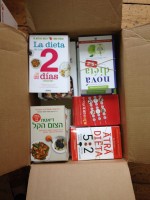I have not got a lot of weight to loose but I started this diet with the hope of loosing about 4kg using the 5:2 method. I am not having any problems with fast days or feed days except that I cannot find any comprehensive calorie counter for home cooked food. For instance, last night for dinner, a non fast day, I had lamb steak 150g with braised red cabbage and I am stuck as how on earth to calculate the calories in the cabbage. It was home made with red wine, balsamic vinegar, sugar and the juice of one orange. The lamb steak was ok,I just calculated from the calories listed in the book and added an extra 100 cals for the shallot sause, but it’s all guesswork really.
I also found that the recipes in the book would not work for me as I will choose quality over quantity every time. I dont mean quality of ingredients so much as quality of taste. I simply cannot be doing all this low fat stuff. To me it tastes absolutely yuk. Steamed vegetables taste of very little – I know I’d have to add a dollop of butter or creme fraiche, and salad with lemon juice – nah, my home-made chilli oil please.
So for me, it is smaller portions but tasty food. I can understand that people who are used to having large platefuls of food, the low calorie recipes are probably more sensible as they can then get more bang for their bucks on fast days, so to speak. But I am disappointed that there doesn’t seem to be any way of accurately counting the calories in home cooked food, I didn’t even find single cream listed, but that was ok as the calories are stated on the pot.
Is anyone else frustrated by this? My husband and I are both keen cooks and always make everything from scratch, so any tips would be really appreciated.






2:05 am
22 Sep 13